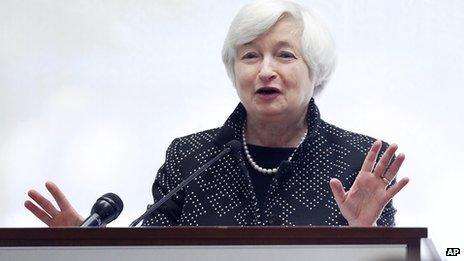US Federal Reserve ends QE stimulus programme
- Published

The US Federal Reserve has announced it is ending its quantitative easing (QE) stimulus programme begun in 2008.
The Fed said it was confident the US economic recovery would continue, despite a global economic slowdown.
The targets for inflation and reduction in unemployment were on track, the Fed said in a statement.
The central bank, which also said it would not raise interest rates for a "considerable time", has gradually cut back QE since last year.
'Sufficient strength'
The statement suggested that although the jobs market is strengthening, it is still not back to normal, which is why interest rates are being held.
"The Committee continues to see sufficient underlying strength in the broader economy to support ongoing progress toward maximum employment in a context of price stability," the Fed said.
Analysts said the news was in line with expectations.
"The Fed's announcement is exactly what everyone expected," said Wayne Kaufman, chief market analyst at Phoenix Financial, in New York.
"The Fed sees enough improvement in economic activity to end QE, but at the same time, it will keep low rates because it isn't yet seeing what it wants to see as far as inflation goes," he said.
Several analysts seized on the Fed's comments about slack in the labour market. Previous policy statements have referred to "significant underutilization of labour resources".
Wednesday's statement left out the word "significant".
Paul Ashworth, chief US economist at Capital Economics, said: "In light of the latest drop in the unemployment rate to below 6%, the dropping of "significant" could be, well... significant."
Brian Jacobsen, strategist at Wells Fargo Funds Management, added: "I was pleasantly surprised that they removed the reference to there being significant underutilization of labour resources.
"I think that is a hat tip to some of the progress being made in the labour market."
US shares were down ahead of the statement and continued to drift lower after the news was announced.
'Milestone'
QE started in November 2008 amid the financial crisis and fears that the US, and the rest of the world, might be facing another great depression.
The Fed's traditional ammunition, cutting interest rates, was running low - there was one more cut the following month, taking the main interest rate target down to practically zero.
So the central bank began buying financial assets and creating new money to pay for them.
In total, the Fed has added $3.7tn worth of assets to its holdings, about an eightfold increase.
BBC economics correspondent Andrew Walker said that although the US economy is improving, the moderate unemployment rate does not tell the whole story.
"There are still many people working part-time who would rather have longer hours, and many people not looking for jobs who are not counted as unemployed but would actually like to work. And long term unemployment is still a serious problem.
"The end of QE will nonetheless be an important milestone in the repair of the US economy," he said.
Recent data has pointed to increase spending by consumers and businesses. However, the housing market is still struggling and pay is stagnant.
There is concern about the long-term impact of the US's persistent low inflation, which risks undermining consumer spending as people delay purchases in the hope that prices will fall further.
- Published30 October 2014
- Published30 October 2014
- Published29 October 2014
- Published3 October 2014